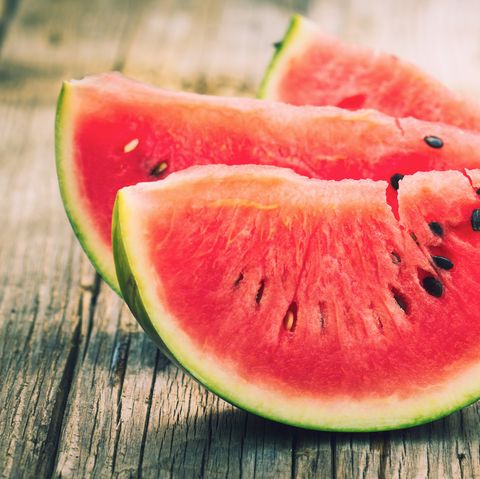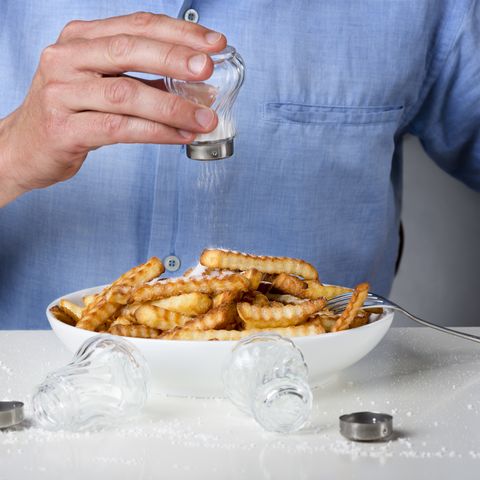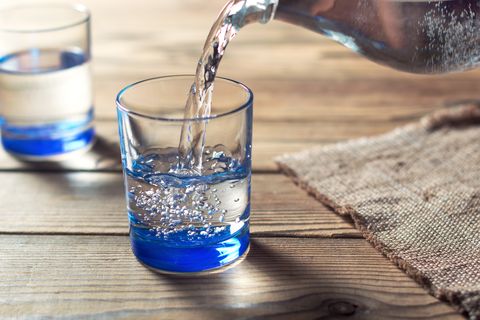Home » Diet & Food »
Believe Any of These 5 Hydration Myths and Your Health Could Suffer
There are a fair number of hydration myths swirling around out there. There’s the big one about drinking eight glasses of water a day (we’ll get to that later, fear not).
Hydration is about so much more than H20. Hydration is about sodium, and potassium, and sweat, and pee (yes, pee!). It’s also not just about what you drink, but what you eat.
But just because hydration as a concept sounds complicated doesn’t mean hydration as a practice isn’t easy.
Avoid these hydration myths and calibrate this balance correctly and you’ll supercharge your health.
Myth #1: Hydration is a daily goal reached by drinking water.
Your hydration balance depends on how much you sweat, your diet, elevation, and even humidity. A healthy diet delivers about 20 percent of fluid intake, says Kim Schwabenbauer, R.D., a USA Triathlon coach.

Getty Images
Turn to watermelon, grapefruit, cucumber, broccoli, apples, and grapes as snacks to increase your fluid consumption. Or naturally flavor your water with berries, lemon, kiwi, pineapples, or oranges.
Studies show that if your fluids are flavored, you’ll drink more.
Myth #2: You can be healthy without good hydration.
Even minor dehydration can affect physical and cognitive performance, as well as overall health.
Imagine your cells are happily swimming around in a pool, awash in an abundance of fluid.
Dehydration reduces the amount of fluid circulating in your bloodstream. This makes your heart work harder, limits your body’s ability to cool itself, and prematurely fatigues your muscles.
Your blood becomes more viscous—thicker, stickier, more concentrated. So don’t shrug off hydration. Pay attention.
Myth #3: As long as you avoid salty foods, you’re fine.
Sodium isn’t evil. You need the nutrient to survive, and your body can’t produce it on its own.

Getty Images
The electrolyte (yes, that’s what sodium is) contributes to blood volume, and, if you’re active, that’s a biggie. Maintaining normal blood volume helps your skin dissipate heat, helps you absorb nutrients, and delivers oxygen to hardworking muscles, including your heart.
Sodium is the mineral lost in the greatest quantities in sweat and urine, and replacing it is essential for proper hydration. So how much is too much? It’s complicated…
What You Lose When You Sweat
1 to 2 % body water loss = Impaired aerobic function; physical work capacity decreased.
2% body water loss = Thirst, increased heart rate, irritability.
4% body water loss = Blood pressure drops, increasing fainting risk. Sweating stops, increasing the risk of overheating.
7% body water loss = Blood slows; may cause organ damage.
(Note: Body water loss of 1% is less than 2 lb. weight loss for a guy weight 175 lb.)
Myth #4: Bananas are great for dehydration cramps.
True, but there’s nothing magical about bananas. The potassium in bananas may be key. Potassium, another electrolyte, helps blunt the effects of sodium and, with help from your kidneys, moves it out of your body.
Think of sodium and potassium on opposite sides of a seesaw, working to balance each other to achieve proper hydration.
Most people get around half the recommended 4,700 milligrams of potassium daily, says Megan Meyer, Ph.D., of the International Food Information Council Foundation. Imbalance can also affect blood pressure and heart contractions.
Myth #5: Everyone needs eight glasses of water a day.
That’s like saying everyone needs to eat 2,800 calories a day. (They don’t.)
Depending on body weight, activity level, and temperature, your daily fluid needs can range from as little as two quarts to more than six quarts per day.

Getty Images
On days when you don’t exercise, assess your pee. Your urine should look more like lemonade than water or apple juice. Dark urine often reflects dehydration.
On days when you work out, weigh yourself pre- and post-exercise. For every pound of weight you lost, you’ll need to drink 20 to 24 ounces (2 1/2 to 3 cups) of fluid to restore balance.
Source: Read Full Article



